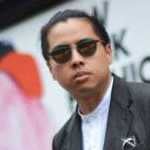
Photographer Justin Chung has built a successful career in the fashion world for images that are organic, welcoming, and have an authentic quality to them. He's shot for GQ, J. Crew, Cereal, Club Monaco, and Business of Fashion. His homegrown, rustic aesthetic translates well into prints, and his newest project, a book called Faculty Department, is a culmination of years of work. Initially started as a website, Faculty Department was a creative outlet for Chung to train his keen eye on the day-to-day of creative individuals like Japanese furniture designer Tokuhiko Kise of TRUCK furniture and menswear icon Frank Muytjens, Head of Men's Design at J. Crew.
The photo essays include written essays that contextualize the work of the people profiled in the book. We sat down with Justin Chung to talk about how the Internet has changed the way we consume photography, an increasingly visual media landscape, and the value of taking a step back and assessing the big picture. Faculty Department is available online and at select retailers for $75. It is printed in Iceland and limited to an edition of 2,800.
1.

Faculty Department started as a website, what made you decide to turn it into a full book?
Well as I started gathering the stories, I just felt that the experience would yield best in a printed form. I shot most of the book on film and sometimes the texture didn’t translate well on the web. It needed to be something that you can physically hold and look at and as I started to shoot more print work I started to appreciate the value in that form. So as I started working on this project and we made the website, I wasn’t happy. I just wasn’t fully satisfied with what I was doing, with the look of it. So I decided to take one step further and decided to do a book form.
We live in a time where just about every other person has a decent camera in his or her pocket. Was shooting on film sort of a slower approach or was it a little bit of commentary on today’s digital visual culture?
Well part of the reason I shot the book on film is I don’t really edit my photos much at all. I try to aim to capture those honest and sincere genuine moments that really just showcase that person. I found that whenever I shoot digital it’s not really as I saw it there. But when I shoot with film and I get the scans back I look at the negatives—then that’s the shot. That’s what I want, that was the moment. Not only did it help make my work feel easier but it was the honest look on that person’s story.
2.

What kind of stories do you want to tell with Faculty Department?
I’m really fascinated with design in my work. I’ve come to appreciate design and more fascinated with architecture and design. I learned a lot about that through the process of this book because I helped the designers to go over their entire layout and I even handled the graphic designers in Vancouver to even to the printing. So I had a deeper sense of appreciation of the whole process of things. I guess that’s why I shot this book mostly on film cause I was interested in the whole process of how film is developed to then being scanned and I guess it goes with the entire philosophy for the project.
What was it that attracted you to the specific individuals you feature in the book?
For me, it was a lifestyle thing, getting to know how they live. I was really interested with their entire life—like how they work, how their home is a part of their work, and vice versa. I really wanted to show that story. For instance, Frank Muytjens [men’s designer at J. Crew], getting a glimpse at his home and going over his book collection. His view towards photography is, in a sense, how he looks at fashion, style, design, his home and his lifestyle.
People today are in a hyper visual world, it’s all about curating a lifestyle via the Internet. As someone with over 20,000 Instagram followers, do you think these platforms are enriching or devaluing photography?
I feel everyone now is becoming his or her own brand. Instagram is a tool where you can define how you want to be seen. So, of course I think it’s valuable and totally useful to define your parameters. When I see all those Instagram images, I’m getting to understand the people more, what they’re into. This visual world we’re in—it’s helping me to understand a different layer of how my friends see the world, and it’s a different way of understanding them.
3.

What about your fashion work? I know that shooting for J.Crew was a life goal that’s since been achieved. Who else would you like to work with?
My goal right now is to keep building this project, but in terms of commercial photography one of my dream clients is Ralph Lauren. I’ve shot for Club Monaco which is owned by Ralph Lauren, and I'd like to shoot for Elle. I guess the ideal would be to find jobs that would allow me to shoot the kind of stories like how I'm approaching Faculty Department.
How does your approach to fashion photography inform how you approach Faculty Department?
Well I think the way I approach all my fashion shoots is the clothes are of course the focus, but I always try and tell the story. I try hard and put a lot of effort into getting to know the models and really let the focus be on them. So I think at the end of the day I approach all my shoots as a portrait.

